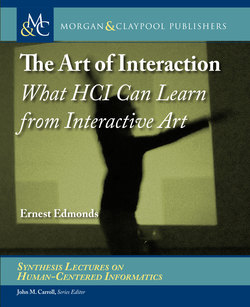Читать книгу The Art of Interaction - Ernest Edmonds - Страница 10
ОглавлениеCHAPTER 1
Introduction
Interactive art has become a common part of life as a result of the many ways in which the computer and the Internet have facilitated it. Human-Computer Interaction (HCI) is as important to interactive art making as the colours of paint are to painting. It is not that HCI and art share goals. It is just that much of the knowledge of HCI and its methods can contribute to interactive art making. This means that artists have been taking a very serious interest in HCI, including as part of their research activities. They have discovered some interesting things that can contribute to HCI. In learning from art, it is important to take the relevant value systems into account and, as art is deeply human, I will come at HCI from a very human perspective. I will not be discussing how to design products that will do well in the market. I will show how art can help HCI in its endeavour to enrich life and expand our understanding of human experience of interaction. This book reviews recent work in the area of art research and proposes contributions that these make to HCI.
Figure 1.1: Shaping Space, Ernest Edmonds. Site Gallery Sheffield 2012. Photo by Robert Edmonds, 2012.
In interactive digital art, the artist is concerned with how the artwork behaves, how the audience interacts with it and, ultimately, in participants’ experiences and their degree of engagement. In this book, I examine these issues and bring together a collection of research results and art practice experiences that help to illuminate this significant new and expanding area. In particular, I suggest that this work points towards a much-needed critical language that can be used both to describe, compare, and discuss interactive systems art and to frame research in HCI, particularly in relation to support for creativity.
This book is, in essence, a lecture. It is written as such and so covers basic background material, some of which most readers will know. However different readers will know different parts of that background. For some, the historical context sections might readily be skipped, depending on the reader’s knowledge. As with all good lectures, the intention is not just to impart information, not even primarily to impart information. The intention is to stimulate thinking about creativity and the future of HCI and to encourage further reading and exploration. At times my text is informal and I do not shy away from expressing opinion that, as yet, I cannot back up with hard evidence. Stimulating questions in the reader’s mind is as important in this lecture as providing answers. The biggest question that I pose is: How best can HCI researchers learn from interactive art?
Digital art is increasingly interactive. Some of it is built on notions that come from computer games and much of it is intended to engage the audience in some form of interactive experience that is a key element in the aesthetics of the art.
This book reviews recent work that looks at the design of interactive systems in the art context. The concerns in HCI of experience design and understanding user engagement are especially relevant ones. We are not so much concerned with task analysis, error prevention, or task completion times as with issues such as pleasure, play, and long-term engagement.
In interactive digital art, the artist is concerned with how the artwork behaves, how the audience interacts with it (and possibly with one another through it) and, ultimately, in participant experience and their degree of engagement. In one sense, these issues have always been part of the artist’s world but in the case of interactive art they have become both more explicit and more prominent within the full canon of concern.
Whilst HCI in its various forms can offer results that at times help the artist, the concerns in interactive art go beyond traditional HCI. Hence, we need to focus on issues that are in part new to, or emerging in, HCI research.
As is well known to HCI practitioners, we do not have a simple cookbook of recipes for interaction and experience design. Rather, we have methods that involve research and evaluation with users as part of the design process. The implications of this point for art practice are, in themselves, interesting. The art-making process needs to accommodate some form of audience research within what has often been a secret and private activity.
This book looks at these issues and brings together a collection of research results and art practice experiences that together help to illuminate this significant new and expanding area. I provide a set of case studies in interactive art research to help guide the reader on that further journey. I also include an extended description of my own journey. On the way I cover a little history, both of HCI and of art. I hope that HCI people might find an expanded way of looking at art—and learn from it—and also that artists might see a new way of looking at HCI.
